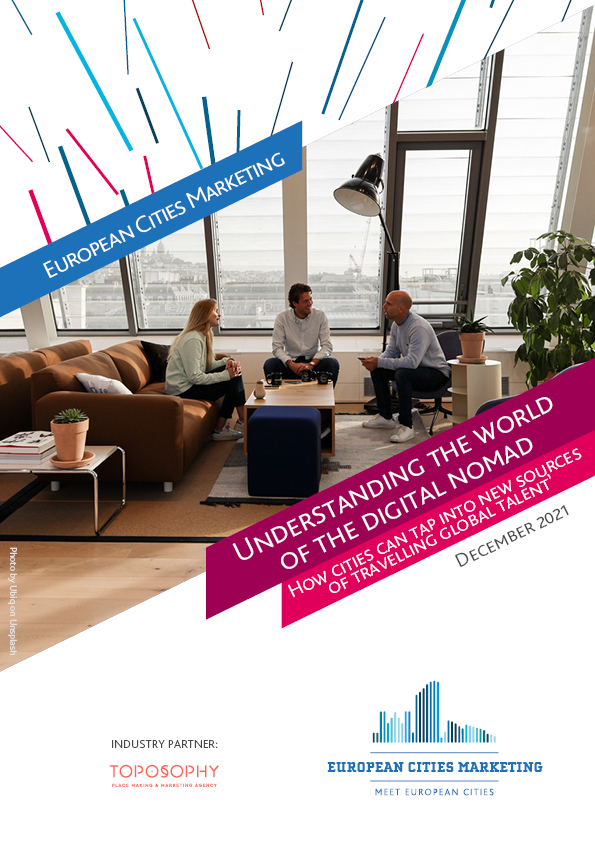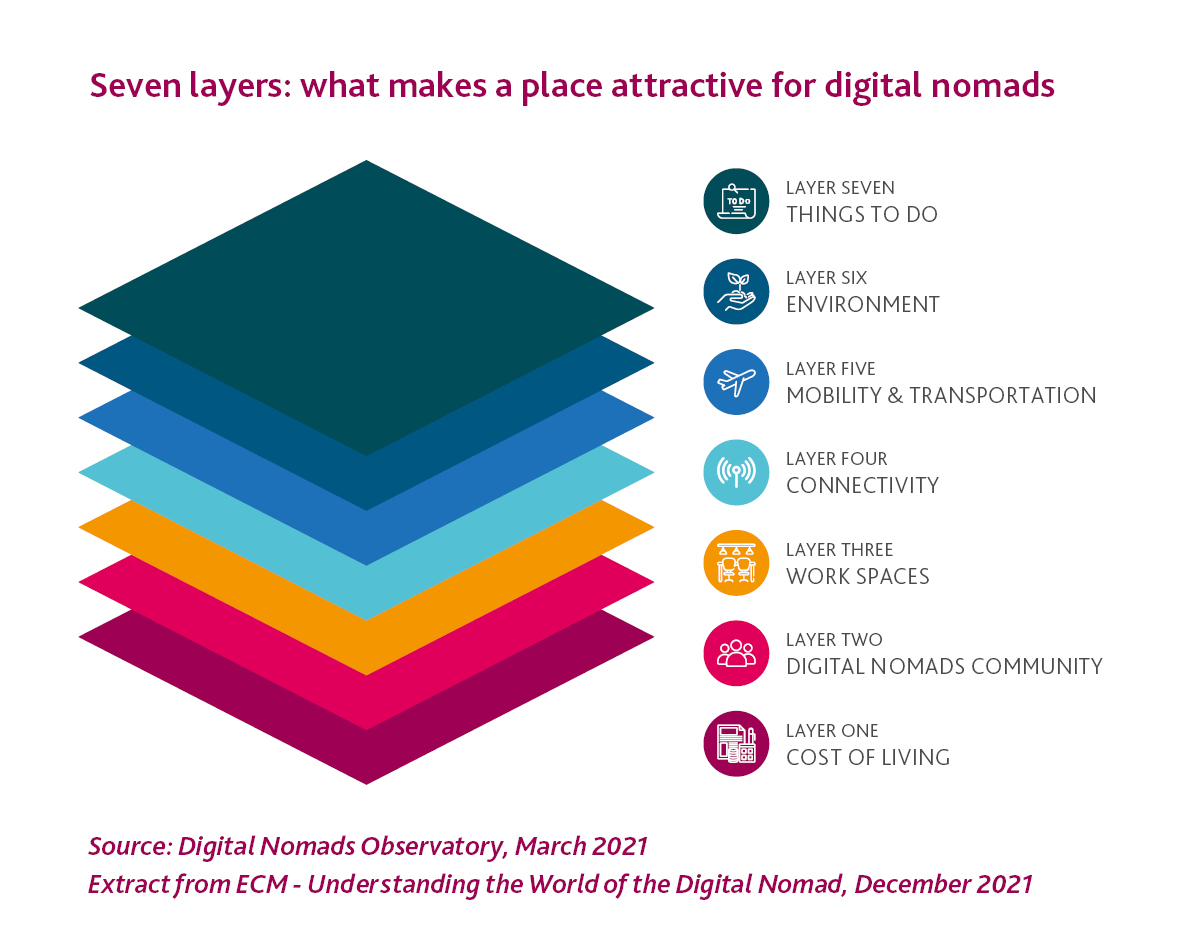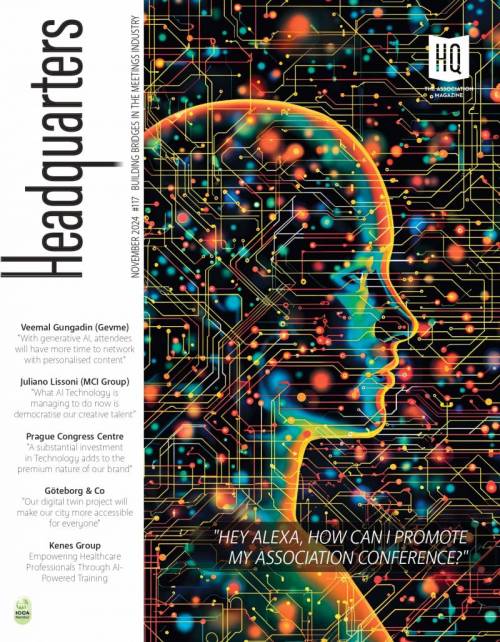How Can Cities Tap into New Sources of Travelling Global Talent?

We hear the words 'digital nomad' all the time, yet who are we really talking about, and why do destinations seem so keen to attract them? To answer this question, European Cities Marketing has launched a ground-breaking report produced in partnership with place making and marketing agency, TOPOSOPHY. We interviewed Manolis Psarros, CEO & Founder of TOPOSOPHY and Petra Stušek, President of European Cities Marketing to learn more about this trend!
1) First of all, can you tell us why the topic of Digital Nomads is so accurate?
 Manolis Psarros: Digital nomads have been on the radar for many years now, and this tribe has clearly seen a boost by the pandemic. We also believe that the ecosystem of businesses that has flourished to service this market can teach us many useful lessons about the wider hospitality industry and how it's evolving to reflect the shifting patterns of how we all work, rest and play in the 21st century.
Manolis Psarros: Digital nomads have been on the radar for many years now, and this tribe has clearly seen a boost by the pandemic. We also believe that the ecosystem of businesses that has flourished to service this market can teach us many useful lessons about the wider hospitality industry and how it's evolving to reflect the shifting patterns of how we all work, rest and play in the 21st century.
Petra Stušek: With the right approach, cities can turn this to their advantage and dip into new sources of attracting global talent. I am proud that ECM tackles this current trend, highlighting concrete tips for destinations, what cities can gain from attracting digital nomads and what they can lose.
2) What can readers expect from this insights’ report?
PS: The report examines the digital nomad lifestyle in more detail and explores the opportunities and challenges that the digital nomad market could bring to cities that want to become more attractive to the ‘long stay’ market. We wanted to showcase different strategic perspectives with a number of inspiring case studies from around the globe; you will be able to track how your city already caters to the market and/or how it can be on the digital nomad map.
MP: You can also find a wide range of practical insights that define who digital nomads really are and what they seek from a place to live and work. We included a comprehensive map of the digital nomad “ecosystem” and explained how cities can make sure they get the most from this dynamic market.
3) What drives people to become digital nomads?
PS: The factors were present long before the emergence of the COVID-19 pandemic - such as the ability to work remotely, or the increased and improved digital infrastructure available for remote workers - however as seen with other trends, the pandemic has accelerated changes in the global labour market.
MP: The global labour market is currently in a state of huge flux. The pandemic is just one of the catalysts that’s pushing professionals worldwide to make dramatic changes to their lifestyle and career. With both workers and employers looking for unprecedented levels of flexibility, we can ask ourselves if this could lead to a new wave of “global nomads”.
4) Anyone able to work remotely can become a digital nomad?
 MP: Unfortunately, becoming a digital nomad is not necessarily a lifestyle open to everyone. From a practical point of view, the availability of visas is strongly dictated by nationality, with considerable inequality around the world between those who are generally able to travel freely and those who are not.
MP: Unfortunately, becoming a digital nomad is not necessarily a lifestyle open to everyone. From a practical point of view, the availability of visas is strongly dictated by nationality, with considerable inequality around the world between those who are generally able to travel freely and those who are not.
PS: Digital nomads and their companies can also meet local legal, tax and other compliance issues when seeking to set up in a new country or even difficulty in accessing local healthcare services. The global digital nomad community has generally become the preserve of those who are white, highly educated and fortunate to have built up enough capital with which to travel. I hope this will change in the future. Maybe, at our level, cities have a role to play through an inclusive approach to attract a more diversified audience of Digital Nomads.
5) What makes a place attractive for digital nomads?
MP: In 2021, the Digital Nomads Observatory introduced seven key layers related to destinations’ ability to attract digital nomads based on a thorough analysis of relevant surveys, desk resources and research. This model outlines how destination assessment involves the seven layers in order of hierarchy: cost of living, community of digital nomads, workplaces, interconnectivity, environment and activities along with an eighth element related to security & freedom. How each destination builds its positioning over these layers is a matter of what particular groups of digital nomads it aims to attract.
6) Since 2015, European Cities Marketing has partnered with TOPOSOPHY to publish Trends and insights reports each year. Can you tell us more about this partnership?
PS: Thanks to our long-standing partnership with TOPOSOPHY, we are able to have a critical overview of the latest international trends in our industry and to provide our members with reports that can definitely help them in their strategic choices. The team once again produced a high-quality report on one of the most important learnings for our industry!
MP: Working with ECM for seven years also allowed us to be in regular contact with 130+ ECM members and partners, which is precious for our work. We are delighted to support the European Cities Marketing community with insights that can help them to think differently about who their cities are attractive to, and why.
7) To conclude, what do destinations looking to attract digital nomads need to know first?
PS: They definitely need to read the report! It’s available on European Cities Marketing’s Website to everyone. Because after all ECM’s credo is “MEET. SHARE. GROW.”!
MP: I wouldn’t have said it better! We also recorded a webinar for the launch of the Report and it’s available on ECM’s YouTube Channel if you wish to learn more about it!
Other Articles
About Us
Supported by the Union of International Associations (UIA), the International Association of Professional Congress Organisers (IAPCO) and the Interel Group, the global public affairs and association management consultancy, Headquarters Magazines serve the needs of international associations organising worldwide congresses.














